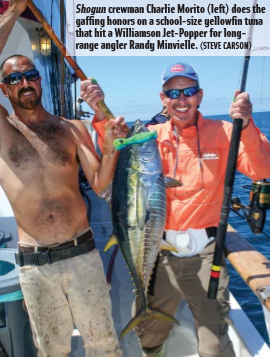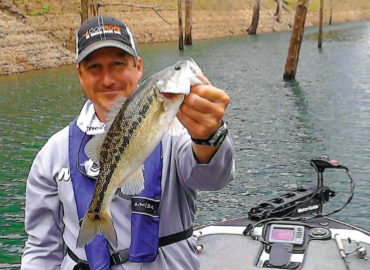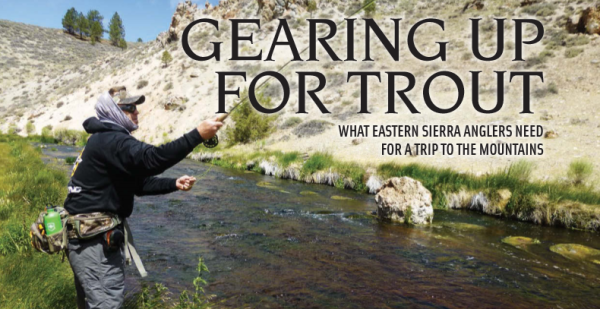To The Blue!
FROM FINDING FLIPPER AND FRIENDS TO TARGETING TEMPERATURE BREAKS AND FISHING PADDIES, HERE’S HOW TO MASTER BLUEFIN TUNA, AS WELL AS DORADO AND YELLOWTAIL
By Chris Cocoles
When Southern California angler Craig Adkinson and his buddies head out of port onto the Pacific Ocean to chase tuna, dorado and

yellowtail, the trip turns into an impromptu dolphin-watching tour.
“We look for porpoise (pods). We’ll follow the dolphins and try to get ahead of them. We’re talking huge groups of a couple hundred together all working bait,” Adkinson says. “They’ll follow the bait, and, of course, the tuna will go with the dolphins. And then the tuna start smashing on the same bait ball. And then you’ll see the birds going crazy.” It’s been another productive summer in the Pacific for the fish species that are usually more prevalent further south in waters off Mexico. But from San Diego north to Orange County and beyond, anglers continue to take advantage of weather patterns that have driven fish to usually colder water.
“The best thing we’ve been finding because the water temperatures have been rising because of what they call the Super El Niño, they’re finding what they call a current break,” Adkinson says. “So you’ll look where there’s a difference in the temperature of the current, where the water temperature goes to, like, 71- to 74-degree water; that’s where all the baitfish travel.”
What boats should be looking for are giant bait balls on their fishfinders, then traveling along the current break and zigzagging the boat in an S-style pattern.
“We catch them by doing what most call fly lining. That’s with a regular tuna rod set-up, with 20-, 30- or 40-pound test, depending on if they’re line-shy or not,” Adkinson says. “We have different set-ups for different grades of fish. So if the fish are in the 20- to 30-pound range, you can use 20-pound line. If the fish are in the 30- to 50-pound range, you use 40-pound test. My buddy just landed a 134-pound tuna on 50-pound line. So that should tell you the line
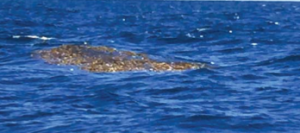
styles.”
There are several hotspots for catching tuna and other species. Adkinson has fished a lot in what’s known as the 209 or 277, between the lower side of Catalina Island and San Clemente Island. The kelp paddies that break off the main islands are an alternative to looking for dolphin and bird activity.
But there’s more than just finding a kelp paddy and fishing it. How you approach such areas is just as critical as how to fish them.
“We see a lot of people do things wrong; they’ll come up to the paddy all super excited and super fast. By doing that, they scare the fish and push the fish down that were under the paddy,”
Adkinson says. “They’ll have engines roaring and music blasting and they get up to it and throw out bait; they wonder why they don’t get bit and they leave.”
It’s also worth noting that sometimes boats won’t stay at a paddy long enough and will leave for another spot prematurely when it appears fish aren’t biting.
Adkinson has learned some tricks from veteran ocean fishermen Chris Rhodes and Dave Pearson. When approaching a kelp paddy and you are within about a football field’s length, slow down the engines to a trolling speed. Then do a loop around the paddy and troll the area. Chunking some bait around it should bring fish like dorado up to the surface.
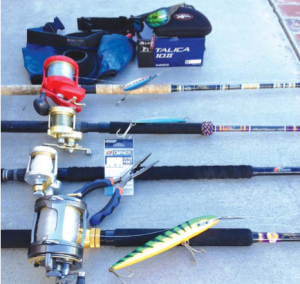
“Once they get excited on the bait you’ll throw your live sardines or mackerel in there. You can hook it in the nose or the stomach – what we call ‘butthooking’ – and it will swim away from the boat better. We’ll just throw it out fly lining; no weight on it and towards the paddy,” Adkinson says.
“As long as your bait is swimming toward the paddy, let it free swim and keep working your spool. If you’re bit, just put it in gear and reel tight. You don’t even have to set the hook. Once you come tight with it the fish is already hooked up. When we fish the paddies we just turn the engines off and just drift.”
As for artificial baits that can catch fish, Adkinson likes a new line of Shimano-made lures: Flat Falls, diamond-style jigs that work well when fishing anywhere 30 to 200 feet down. It’s a simple way to fish these spoons: tie it on and let it sink as far as your line will let out. Tuna love these baits. Adkinson also trolls with Magnum Rapalas or tuna feathers.
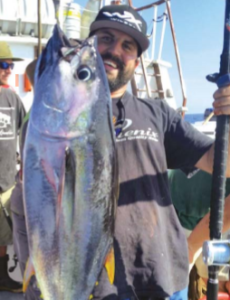
“These are pretty simple set-ups. The techniques to catch them are fairly simple,” Adkinson says. “The hardest part is finding the fish.” CS

